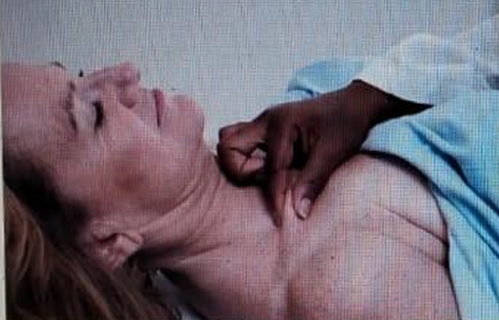The nurse performs the action shown in this image during the assessment of a client. What is the nurse assessing?

Intercostal spaces
Lymph nodes
Skin Turgor
Carotid Pulse
The Correct Answer is C
A) Intercostal spaces:
Assessing intercostal spaces typically involves palpating or inspecting the area between the ribs to check for abnormalities such as retractions or tenderness, usually conducted with the client sitting or standing.
B) Lymph nodes:
Palpation of lymph nodes, such as in the cervical region, involves using fingertips to gently feel for enlarged or tender nodes. This examination focuses on areas like the neck, underarms, and groin.
C) Skin Turgor:
The image depicts a nurse pinching the skin, likely on the chest or forearm, which is a common method to assess skin turgor. Skin turgor evaluation helps determine hydration status; if the skin remains tented and returns slowly to its original position, it indicates dehydration.
D) Carotid Pulse:
Assessing the carotid pulse involves palpating the carotid artery along the side of the neck to evaluate the strength and rhythm of the pulse. This is typically done using the pads of the fingers, not by pinching the skin.
Nursing Test Bank
Naxlex Comprehensive Predictor Exams
Related Questions
Correct Answer is B
Explanation
A) Color discrimination:
Color discrimination involves assessing the client's ability to differentiate between various colors, typically using color plates like the Ishihara test. This test is often used to detect color blindness or deficiencies in color vision. The action depicted in the image, which involves reading text up close, is not relevant to assessing color vision capabilities.
B) Near vision:
Near vision is assessed by having the client read small text or print held at a close distance, often using a near vision chart or card. The image shows the client covering one eye with an occluder while reading text, which is a common method to test the clarity and focus of near vision. This helps determine if the client has issues such as presbyopia, which affects near vision acuity.
C) Distance vision:
Distance vision is typically evaluated using a Snellen chart, where the client reads letters or symbols from a distance of 20 feet. The test aims to assess the clarity of vision at a distance. The action in the image does not align with this type of assessment, as it focuses on close-up reading rather than distance.
D) Intraocular pressure:
Intraocular pressure is measured using tools like a tonometer to assess the fluid pressure inside the eye, which is crucial for diagnosing conditions like glaucoma. This test involves specific instruments and procedures, unlike the reading task depicted in the image, which is unrelated to measuring eye pressure.
Correct Answer is D
Explanation
A) Electrical cords are placed along the walls: While it is important to ensure that electrical cords are safely managed, cords placed along the walls are less likely to pose a tripping hazard compared to those that are left loose or run across walking paths. This setup, in itself, is generally not a significant safety risk if managed properly.
B) Handrails are present in the bathroom: Handrails in the bathroom are actually a safety feature, not a risk. They provide necessary support for older adults with decreased vision or mobility issues, helping to prevent falls when using the toilet or getting in and out of the bathtub or shower.
C) Uses a microwave for cooking: Using a microwave for cooking is generally considered safe for individuals with decreased vision, as it minimizes the risk of burns and other injuries associated with using a stove or oven. The microwave can be a safer cooking method if the client is familiar with its operation.
D) Scatter rugs are present in the kitchen: Scatter rugs are a significant safety risk, especially for older adults with decreased vision. These rugs can easily cause trips and falls, leading to potentially serious injuries. Removing scatter rugs or securing them with non-slip backing can help mitigate this risk and create a safer home environment.
Whether you are a student looking to ace your exams or a practicing nurse seeking to enhance your expertise , our nursing education contents will empower you with the confidence and competence to make a difference in the lives of patients and become a respected leader in the healthcare field.
Visit Naxlex, invest in your future and unlock endless possibilities with our unparalleled nursing education contents today
Report Wrong Answer on the Current Question
Do you disagree with the answer? If yes, what is your expected answer? Explain.
Kindly be descriptive with the issue you are facing.
